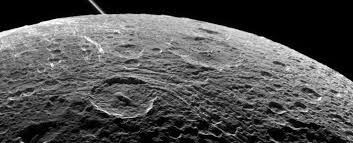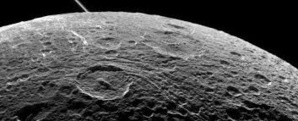Even though the Moon is uninhabitable today, there could have been two windows earlier when there could have bene life there, suggested American and British scientists.
The first window could have been soon after the Moon was created from a debris disk four billion years ago while the other window was possibly during a peak in lunar volcanic activity about 3.5 billion years ago, claimed a new study that was published on Monday in the journal Astrobiology.
The Moon’s core was continuously throwing out large amounts of superheated volatile gases, including water vapor, during the both the periods, said Schulze-Makuch, an astrobiologist at Washington State University and Ian Crawford, a professor of planetary science and astrobiology at the University of London.
According to the study, pools of liquid water on the lunar surface and an Moon atmosphere that was dense enough to be kept there for millions of years could have been formed by the outgassing there4 during the periods.
"If liquid water and a significant atmosphere were present on the early Moon for long periods of time, we think the lunar surface would have been at least transiently habitable," Schulze-Makuch said.
Hundreds of millions of metric tons of water ice on the Moon were discovered on the surface of the Moon was discovered by scientists of an international team in 2009 and 2010. Further, scientists have found very strong proof that there existed a large quantity of water in the lunar mantle which scientists believe had been deposited at the very early stages of the formation of the Moon.
Additionally, according to the researchers, lifeforms on the surface would likely have bene shielded from the deadly solar winds by a magnetic field – that also protected the Moon, during its early formation period.
While it is believed that as it happened on the Earth, life on Moon could have started in a similar manner – if at all. However, the more likely scenario according to scientists for the formation of life on the Moon is that it could have travelled to its surface on a meteorite, Schulze-Makuch said.
Fossilized cyanobacteria that are between 3.5 and 3.8 billion years old are the possible evidence of the earliest evidence for life on Earth. Frequent and giant meteorite impacts had dominated the solar system at that time.
According to the researchers, there is a possibility that simple organisms like cyanobacteria sitting on meteorites could have been off the surface of the Earth and landed on the Moon.
"There could have actually been microbes thriving in water pools on the Moon until the surface became dry and dead," Schulze-Makuch said.
(Source:www.xinhuanet.com)
The first window could have been soon after the Moon was created from a debris disk four billion years ago while the other window was possibly during a peak in lunar volcanic activity about 3.5 billion years ago, claimed a new study that was published on Monday in the journal Astrobiology.
The Moon’s core was continuously throwing out large amounts of superheated volatile gases, including water vapor, during the both the periods, said Schulze-Makuch, an astrobiologist at Washington State University and Ian Crawford, a professor of planetary science and astrobiology at the University of London.
According to the study, pools of liquid water on the lunar surface and an Moon atmosphere that was dense enough to be kept there for millions of years could have been formed by the outgassing there4 during the periods.
"If liquid water and a significant atmosphere were present on the early Moon for long periods of time, we think the lunar surface would have been at least transiently habitable," Schulze-Makuch said.
Hundreds of millions of metric tons of water ice on the Moon were discovered on the surface of the Moon was discovered by scientists of an international team in 2009 and 2010. Further, scientists have found very strong proof that there existed a large quantity of water in the lunar mantle which scientists believe had been deposited at the very early stages of the formation of the Moon.
Additionally, according to the researchers, lifeforms on the surface would likely have bene shielded from the deadly solar winds by a magnetic field – that also protected the Moon, during its early formation period.
While it is believed that as it happened on the Earth, life on Moon could have started in a similar manner – if at all. However, the more likely scenario according to scientists for the formation of life on the Moon is that it could have travelled to its surface on a meteorite, Schulze-Makuch said.
Fossilized cyanobacteria that are between 3.5 and 3.8 billion years old are the possible evidence of the earliest evidence for life on Earth. Frequent and giant meteorite impacts had dominated the solar system at that time.
According to the researchers, there is a possibility that simple organisms like cyanobacteria sitting on meteorites could have been off the surface of the Earth and landed on the Moon.
"There could have actually been microbes thriving in water pools on the Moon until the surface became dry and dead," Schulze-Makuch said.
(Source:www.xinhuanet.com)






